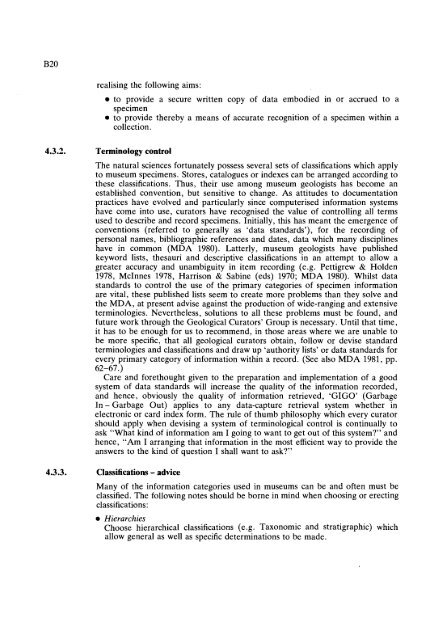GUIDELINES FOR THE CURATION OF GEOLOGICAL MATERIALS
GUIDELINES FOR THE CURATION OF GEOLOGICAL MATERIALS
GUIDELINES FOR THE CURATION OF GEOLOGICAL MATERIALS
You also want an ePaper? Increase the reach of your titles
YUMPU automatically turns print PDFs into web optimized ePapers that Google loves.
ealising the following aims:<br />
m to provide a secure written copy of data embodied in or accrued to a<br />
specimen<br />
m to provide thereby a means of accurate recognition of a specimen within a<br />
collection.<br />
4.3.2. Terminology control<br />
The natural sciences fortunately possess several sets of classifications which apply<br />
to museum specimens. Stores, catalogues or indexes can be arranged according to<br />
these classifications. Thus, their use among museum geologists has become an<br />
established convention, but sensitive to change. As attitudes to documentation<br />
practices have evolved and particularly since computerised information systems<br />
have come into use, curators have recognised the value of controlling all terms<br />
used to describe and record specimens. Initially, this has meant the emergence of<br />
conventions (referred to generally as 'data standards'), for the recording of<br />
personal names, bibliographic references and dates, data which many disciplines<br />
have in common (MDA 1980). Latterly, museum geologists have published<br />
keyword lists, thesauri and descriptive classifications in an attempt to allow a<br />
greater accuracy and unambiguity in item recording (e.g. Pettigrew & Holden<br />
1978, McInnes 1978, Harrison & Sabine (eds) 1970; MDA 1980). Whilst data<br />
standards to control the use of the primary categories of specimen information<br />
are vital, these published lists seem to create more problems than they solve and<br />
the MDA, at present advise against the production of wide-ranging and extensive<br />
terminologies. Nevertheless, solutions to all these problems must be found, and<br />
future work through the Geological Curators' Group is necessary. Until that time,<br />
it has to be enough for us to recommend, in those areas where we are unable to<br />
be more specific, that all geological curators obtain, follow or devise standard<br />
terminologies and classifications and draw UD 'authoritv lists' or data standards for<br />
every priiary category of information withh a record (See also MDA 1981, pp.<br />
62-67.)<br />
care and forethought given to the preparation and implementation of a good<br />
system of data standards will increase the quality of the information recorded,<br />
and hence, obviously the quality of information retrieved, 'GIGO' (Garbage<br />
In - Garbage Out) applies to any data-capture retrieval system whether in<br />
electronic or card index form. The rule of thumb philosophy which every curator<br />
should apply when devising a system of terminological control is continually to<br />
ask "What kind of information am I going to want to get out of this system?" and<br />
hence, "Am I arranging that information in the most efficient way to provide the<br />
answers to the kind of question I shall want to ask?"<br />
4.3.3. Classifications- advice<br />
Many of the information categories used in museums can be and often must be<br />
classified. The following notes should be borne in mind when choosing or erecting<br />
classifications:<br />
m Hierarchies<br />
Choose hierarchical classifications (e.g. Taxonomic and stratigraphic) which<br />
allow general as well as specific determinations to be made.

















